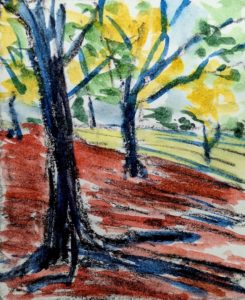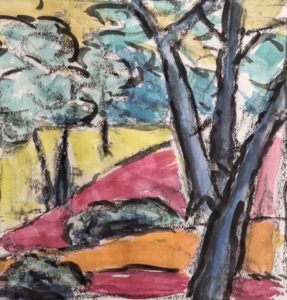A Thought on Art…
by Dieter Michael Feurich

A brief Conversation about Seeing and Art
Tino:
The park was so beautiful today. I took lots of pictures of the trees, their trunks and branches, with the sun playing in the leaves. There were golden, green, and brown colors everywhere.
And yet, I feel I am not really capturing anything. What I mean is I am not absorbing what I see, the images remain at the surface, they are not really sinking in.
I took those pictures with amazing accuracy and efficiency, and I am taking them home, look at them, share them, and yet they are somehow dead, they are not conveying the wonderful feelings and thoughts I had when I was surrounded by the trees and the sun and the warmth.
I feel like I am merely using an advanced technological process to copy something that is not mine.
Carl:
Why don’t you paint them?
Tino:
Paint them?
Carl:
Yes, or better: Why don’t you try to paint pictures that capture your feelings or that allow you – in the process of painting – to really absorb the images and express your feelings?
And no, I do not mean to copy the pictures you took today with your phone but try and paint the images that grow out of yourself, that stem from your own image and idea collection, if you will. As an artist, you have been building a collection of artistic ideas over many years.
Tino:
Have I?
Carl:
Well, I hope so! And you probably already have – subconsciously – added some of today’s impressions and feelings from the park to that collection.
Tino:
Have I?
Carl:
Sure. This ever expanding and changing internal imagery of ours should be the source of artwork, if we really want it to be ‘ours’.
Tino:
So, I need to look into myself rather than the outside world to produce art?
Carl:
It is both. What I mean is that the art we produce, for example paintings or prints, should come into being as a synergy of outward and inward experiences. Your outward eye and your inward eye meet, so-to-speak.
You saw something beautiful today and you would like it to linger a bit because you want to enjoy the experience after it is over. If your impressions fall on a fertile ground, they will take root and grow and bear fruit. That ground is your personal, carefully developed and guarded, collection of feelings, thoughts, and experiences. It is like a treasure chest, and I think all artists have one – if they are true artists.
Tino:
Hmm, I never thought of that.
Carl:
And if you decide to admit your impressions or visual experiences to your personal treasury, make them part of it, and then allow images to grow over time that reflect what you see with your outer and your inner eye, then your art is really yours. It is then part of you, and you are part of it. That is something very different from taking a picture with your camera.
Tino:
Sounds difficult. One has to be very conscious of oneself and think a lot before you can even start working. I am not sure I could do that.
Carl:
Yes, you can, because you already have an ‘art identity’ if you will. You have an artistic personality that has been growing organically for a long time. It is the accumulation of all your past experiences in art, nature, literature, love, whatever. You only need to be conscious of it and allow it to come to the surface and take a direct influence on your work.
Tino:
I do not think I’d be able to convert what you are saying into actual paint on the canvas or ink on the printing block.
Carl:
Why wouldn’t you?
One key to a good work of art is the formation of a mental image of it before you even pick up a brush or a cutter. At least that’s what I think (I also think that great artists work that way, even artists who seem to work in a random kind of way like Pollock or Paul Tonkin).
And forming a mental image does not mean you must have a detailed plan, only a reasonably well-defined idea that you’ll develop as you go. And that idea is being fed by who you are as an artist and by what you see or read or feel.
Once you have that mental image, getting it on the canvas or printing block is just technique that can be learned.
Tino:
You know some of my work. What do you think who I am as an artist?
Carl:
I know some of your output, but I cannot know its source or the input. Only you would know that. We are talking about something personal that cannot simply be read from somebody’s work.
Tino:
But I am lost now: I should be able to make art without thinking about all that, no? Why can I not just make a print or a painting because the subject matter appeals to me, and I feel like doing it? Without thinking about my personality as an artist?
Carl:
But the fact that a subject matter appeals to you, and you feel like it, probably already shows the influence of your artist personality; otherwise, you would not bother with it. There is no need to think hard about it. Just allow yourself to be yourself when making art.
Tino:
Allow myself to be myself…
Carl:
Yes. So, instead of just painting a good likeness of a scene or a person, be bold and transform what you see into an image that is really yours because of the choices you have made in the process.
Your artistic being should guide you. It is like a pond in which things fall and sink to the ground – if we let them. Those things are memories, wishes, thoughts; things we have seen in nature, in the city, in art; things that come to our minds when reading a poem, or when listening to the birds; anything that speaks to us somehow.
Many things do not speak to us, and we do not admit them to our ‘pond’; they will not sink and settle, they will float, if you will. I can name a number of famous and popular artists, for example, whose work does not tell me a thing – no matter how much people pay for their works. I do, subconsciously, not permit them to influence my artistic personality – but that may change in the future.
We are making these decisions – whether to admit or reject an influence – subconsciously all the time. But there are no hard and fast rules: we may embrace new influences that years ago we would have rejected and vice versa. Our artistic personality is changing over time and that’s ok – as long as it is really ours and as long as we keep an open mind.
That way we are building a ‘ground’ at the bottom of the pond so-to-speak, a fabric, colorful, unique to us, and becoming thicker and stronger with time. Making art is a personal thing. We must bring ourselves into it by building upon and drawing from that fabric that makes up our individual artistic personality. That is what I mean by seeing with both our inner and outer eye.
Tino:
So, if I wanted to make a painting, I should have a mental image of it, one that is in agreement with my artistic personality, right?
Carl:
No, I told you, it is not that rigid. Your idea for a painting or print is probably already rooted in who you are as an artist – otherwise you would not have the idea in the first place. It is just a matter of thinking it through a bit and give it some shape in a natural and unforced way.
This ‘fabric’ or ‘treasure chest’ I am talking about is not just a depository of thoughts and impressions, but it is a source of ideas, oftentimes triggered and modified by what we see.
You already may have a vague idea of what you want your painting to look like. Now it is important to free yourself from the immediate accurate, high-resolution images on your camera and in your head (Next time you go to the park, take a sketch pad and leave your camera at home – yes, I know that’s impossible with our cellphones nowadays – unfortunately).
But seriously, the primary source of your thought process when thinking about the painting you want to create is your personal artistic imagery, the fabric at the bottom of your pond. The immediate outward images are merely triggers, pointers, roughly defining the subject matter.
Maybe the best paintings are made from memories, from things or situations we have experienced years ago and that we now see in a haze, not exactly defined so that all superfluous detail vanishes.
So: build your mental images upon your inner artistic fabric, not upon the immediate outward impressions you happen to be subjected to.
Tino:
Ok, I will try that.


